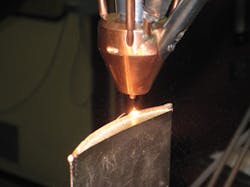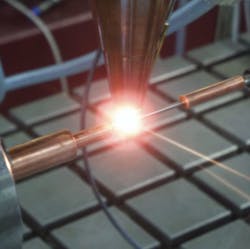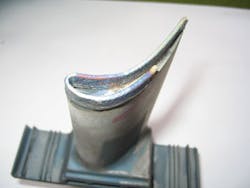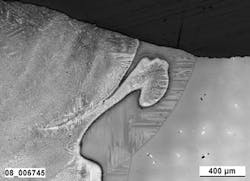Coatings against wear, erosion, and corrosion becoming popular
Thomas Peters
It's only natural to want our largest investments to last as long as possible, especially in today's volatile economic times. This is particularly true with industrial gas turbine components, which are expensive to manufacture and replace, so it makes sense to pair these investments with the most efficient repair technology. The main purpose of industrial gas turbines is power generation, but they also function to drive compressors or pumps in special environments such as oil rigs and oil fields.
The high-value components are placed behind a combustion chamber, where they are subjected to the extremely high temperatures of the hot gases. To withstand these punishing conditions, the hot gas path components are made from high-temperature, nickel-based super-alloys. However, the super-alloys' durability also makes these materials difficult and sometimes impossible to repair using conventional welding processes.
Though various coating technologies exist to repair and rebuild these parts, laser cladding is becoming the preferred method because of its highly localized heat input, wide material availability, and increased weldability of temperature-sensitive materials. Over the past 15 years, technicians have increasingly incorporated automated laser cladding in favor of manual conventional welding processes, such as tungsten inert gas (TIG), to repair turbine components. In fact, industrial gas turbines and aero engines are the driving industry behind laser cladding innovation.
What is laser cladding?
Laser cladding involves light that melts the material on the surface of the part to be coated. A powder nozzle then transfers metal powder into the melt pool to form a metallurgical bond. The laser optic and powder nozzle move over the work piece surface, producing single tracks or layers or more complicated weld build-ups.
In use since the 1990s, laser cladding's rising popularity in turbine repair is partly attributed to a decline in price. Initially, the laser itself was cost prohibitive, which made laser cladding a high-priced investment for technicians. However, new laser types, such as diode, fiber and disc, have been developed to make laser cladding increasingly affordable. Compared with the traditional CO2 or Nd:YAG laser, these new lasers require little maintenance, have high-electrical efficiency, and lack sensitive components or optics. As a result, investment costs over the past five years have further decreased by approximately half.
In addition to industrial gas turbines and aerospace components, laser cladding is becoming more affordable for general industrial applications, such as oil and gas and mining tools, piston engines, compressors, pumps, and even agricultural equipment.
Laser cladding's advantages
Laser cladding is well known for causing little to no distortion to the substrate. This is due to its highly localized heat input that forms the metallurgical bond by melting the materials, critical for high-precision parts like mold tools and sheet metal structures. The high temperatures of conventional welding processes can greatly stress the part and cause further damage.
However, laser cladding's greatest advantage is not as renowned: The weldability of temperature-sensitive materials like super alloys and high-carbon steels has greatly improved. TIG welding produces a substantially higher heat input, which in turn causes more welding defects, such as cracks. Consequently, TIG has become less preferred for repairs on hot gas path components.
Laser cladding's second major advantage is higher geometrical accuracy, which results in less material applied than with a conventional welding process. Compared to TIG welding, laser cladding generates a near-net-shape build up and has a cleaner finish for finer geometry, creating less material overhang. An example of this is a blade tip requiring a 6 mm build up. Laser cladding can produce weld build up to around 0.3 mm at the turbine blade sides; conversely, TIG welding would create an overhang of up to 2 mm, causing more material to be applied and then removed, resulting in a higher finishing effort and increased labor.
Additionally, the computer numerical control (CNC) system makes the laser cladding process largely reproducible, which allows technicians to repeat high welding quality during production.
Three-dimensional geometries
Components such as turbochargers are full of twists and turns that present particular challenges with the coating materials and processes. Thus, this three-dimensional (3D) geometry requires an appropriate handling system capable of moving the part as necessary. The programming of the welding tracks requires sufficient computer-aided manufacturing (CAM) tools. Additionally, the programmer of a laser cladding system needs an adequate understanding of the laser cladding process to generate an appropriate welding strategy. This strategy must consider material issues, such as overheating in the edges, as well as geometry issues, such as deviations in geometry resulting from either the part manufacturing process or the part's previous operating conditions.
Methodology
Like every welding process, laser cladding requires a sufficient preparation of the surface upon which the weld is performed. Often the first step is removing additional material to ensure a strong foundation for repair. For example, a turbine blade tip that incurs cracks from hot gas corrosion or rubbing damage returns to the production plant for refurbishment. Technicians would first need to eliminate the damaged area before beginning the rebuilding process.
Since laser cladding is a CNC process, information about the part geometry, either as a 3D-CAM-model or from digitized data, is needed to generate the welding tracks. The appropriate welding strategy often results from a qualification process. This process involves the customer, who decides the acceptance criteria regarding geometry of the weld build-up and welding quality.
Process qualification includes the determination of the correct process parameters. These parameters include the laser power, the adjusted focal diameter of the laser to define the size of the melt pool and weld track width, the feed rate to determine the speed that the processing head moves over the part, and the powder rate or the amount of powder transferred into the melt pool.
Inside the microscopic coating
Though unseen to the naked eye, the application can be actually composed of two distinct layers, sometimes three with a buffer layer. The microscopic view of a laser cladding application involving Stellite 694 with a MetcoClad 625 buffer on CMSX-4 is shown. The right side of the photo shows the CMSX-4's single-crystal material, with the crystal orientation aligned in one direction but not visible.
The middle area (MetcoClad 625) is applied during the laser cladding process as a buffer layer. MetcoClad 625 is a ductile material that protects the base material from cracking or damage when the Stellite hard facing is later applied. The horizontal and vertical lines of the crystallic structure actually stem from the CMSX-4 and form when the MetcoClad 625 solidifies. The Stellite 694 on the left side is the functional surface - a wear-resistant coating for a high-temperature environment.
Conclusion
With its higher geometrical accuracy and less thermal stress, laser cladding provides a clear advantage over conventional welding processes and has become the standard for high-value part repairs. Industrial gas turbine refurbishment will continue to lead innovations, virtually making laser cladding a customized solution for this industry. As more processing plants incorporate this technology, functional coatings against wear, erosion, or corrosion will become increasingly popular. Experience and thorough application know-how will remain the keys to successful operation of laser cladding systems.
Thomas Peters ([email protected]) is project manager, business development, laser cladding, at Sulzer Metco Inc, Westbury, NY.




